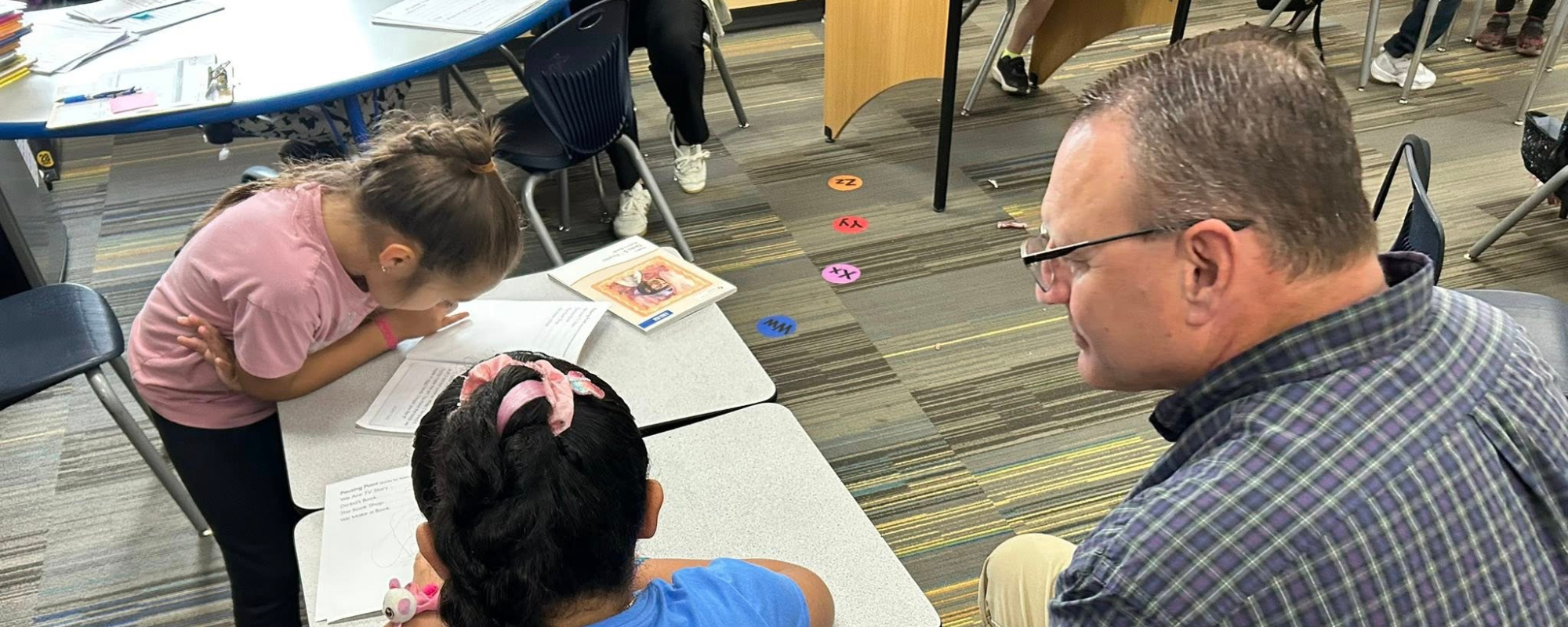Synder ISD Trustees Improve Governance with Campus Visits
Trustees sitting in the TASB Summer Leadership Institute session in Fort Worth did not hide their skepticism. The idea being presented by the enthusiastic assistant superintendent from Snyder ISD was met with more than a few shaking heads, but they heard her out.
“We transformed board members’ understanding of what was actually happening in classrooms,” Jessica Gore, Snyder ISD assistant superintendent, explained to the roomful of school board members and superintendents.
In the West Texas district of 2,300 students, trustees join district and campus leaders in monthly scheduled visits to classrooms, where they observe lessons, interact with students, and gain insight into instructional strategies.
“This is pushing the envelope,” said Brad Hinton, president of the Snyder ISD board, referring to the school board’s governance role. “But I have seen the benefits of it.”
Snyder ISD has adopted instructional rounds, a practice that invites trustees to step into learning spaces, observe teaching in action, and connect with students and educators on a more personal level. Modeled after medical field practices, instructional rounds, commonly called board walks, give leaders a clearer picture of how learning unfolds day to day.
“When I see things, I understand them,” Hinton said. “When I see it, it becomes real to me.”
Staying In Your Lane
Snyder ISD Superintendent Bob Rauch understood the hesitation among school leaders in the room when he presented at SLI in both San Antonio and Fort Worth with Gore, Hinton, and Valerie Morris, the district’s director of communications.
“I get it,” Rauch said. But he and his staff wanted to explain how they have found a way to engage their board members to help them work through decisions and support them with information for when they are out in the community.
“A lot of different stories were going around about campuses,” Rauch said. “As those concerns were brought to me [by individual trustees], I would scratch my head a little bit. I hear what they are saying, but when I walk the halls and go into classroom, I’m not seeing the same scenario as the stories that are being told out there.”
Rauch and his team decided a good way to better engage the board was through the instructional round process so that trustee conversations in the community could be grounded in firsthand experiences from classrooms across the district.
“We needed to get them more involved in the instructional and academic processes and systems we utilize,” he said.
Both Rauch and Hinton know that this plan can cause some governance concerns about “staying in your lane.”
“When I first became a board member, I wanted to go check in on all the campuses and make sure everyone was doing the job they needed to be doing,” Hinton said. “Came to find out real quick that was not my job.”
Both agree that this process, launched about three years ago, builds trust and aligns district-wide strategies from the classroom to the boardroom — but it requires a delicate balance between oversight and management.
“Instructional rounds shift governance from compliance-driven oversight to informed, engaged leadership,” Rauch said.
Walks Build Trust and More
There is a distinct method to this madness.
At the beginning of the school year, the administration is on campuses building relationships, which Gore said is key to making instructional rounds work. “We go out the first two weeks when teachers are hungry for help and just never leave.”
By covering classrooms and lunchrooms, greeting students as they arrive at school, and generally being on hand to assist wherever needed, the administration becomes a familiar presence in classrooms and hallways across the district.
This sets the stage for the monthly instructional rounds that are scheduled for the first Wednesday of the month throughout the school year. The process is structured but approachable. Rauch sends out a general invite to trustees who are available, being sure to keep the number who accept below the threshold for a quorum.
Each round begins with a brief meeting with the superintendent about what classrooms the group will visit and what instructional practices they might observe, providing context on the lesson focus, instructional strategies, and district goals. Trustees head out armed with clipboards holding a schedule for the day, a rubric on instructional practices for reference, and a stack of sticky notes.
Trustees, along with a few campus leaders and occasionally outside observers, then rotate through about 20 classrooms on multiple campuses, typically spending 5-10 minutes in each.
Hinton stresses that these visits are not staged and trustees might see anything and everything during a round.
“What is amazing to me is when a board member can walk in and out of these classes,” Hinton said, noting that insights and observations from a board walk have the potential to help inform decisions in the boardroom later, especially those related to programs and personnel. “It’s really powerful for board members to see the inside workings of a school system.”
Rauch noted that board members often don’t have an educational background and have to make difficult decisions. “It helps you to have eyes on what is going on in classrooms.”
Board walks help build trust when trustees have seen firsthand the agenda items that are being presented in meetings.
“We have enhanced governance when they understand the ‘why’ behind a proposal,” Gore said. “When we put something on the board agenda for action, it can’t be the first time they have seen it. They have to have seen the runway gearing up for a decision we are asking them to vote on as a team of seven.”
Celebrating Great Teaching
After the board walks, trustees debrief with campus leaders to share observations and reflections. The emphasis is on trends, not individuals, which keeps the focus on the learning environment rather than on performance evaluations. The goal is to foster understanding, celebrate strengths, and identify areas where resources or support might make a difference.
“This is an evidence-based, student-centered approach,” Gore emphasized.
The sticky notes play an important role, too. Board members are encouraged to jot down specific positives they observed — such as the way a teacher engaged students in discussion or incorporated technology into a lesson — and leave the notes behind as a gesture of appreciation.
“Board members pull me to the side and say, ‘She is amazing!’ and I say, I know. Why don’t you send her an email and let her know how great she is,” Gore said. “Because, man, when you get an email from a board member or from me saying board president Hinton couldn’t believe what he saw in your classroom today, that changes the experience of what a governing body does in a district.”
District officials make a point of involving a wide variety of campus leadership in the walks. Alongside trustees and district administrators, principals, assistant principals, instructional coaches, and department heads take part in instructional rounds. The athletic director, the head of maintenance, or the director of finance might join a board walk. This broad participation ensures multiple perspectives are represented and helps build shared ownership of instructional priorities across the district.
“It unites the family,” Gore said.
The impact has been notable. Board members report a clearer understanding of the challenges and opportunities teachers face. This perspective shapes conversations during board meetings, where decisions about curriculum, staffing, and resources now come with real-life context.
Snyder ISD trustees backed a bond election for this November with a 7-0 vote. Rauch credits the time they spent on campuses as playing a key role in its passage. Gore points to the fact that board members witnessed a bucket collecting water from a leak in a high school classroom as one of many experiences that had an impact.
By opening classroom doors, Snyder ISD has opened up a new dialogue between trustees and administration. The result is a stronger partnership, deeper trust, and a board that is more informed and engaged in the daily realities of education. Board walks are not just a strategy — they’re a bridge connecting governance to the heart of learning and building positive community messaging.
Morris, the communications director, points out that board walks have become a powerful tool for trustees. “Instructional rounds are a flashlight into what’s going on in the district and provide you with insight so you can go out and be an advocate for your district and your community.”
Photo: Snyder ISD Superintendent Bob Rauch looks on as students work during a board walk visit to a Snyder Primary School classroom.
This article first appeared in the October/November 2025 issue of Texas Lone Star.
Beth Griesmer
Beth Griesmer is a senior communications specialist for TASB.





